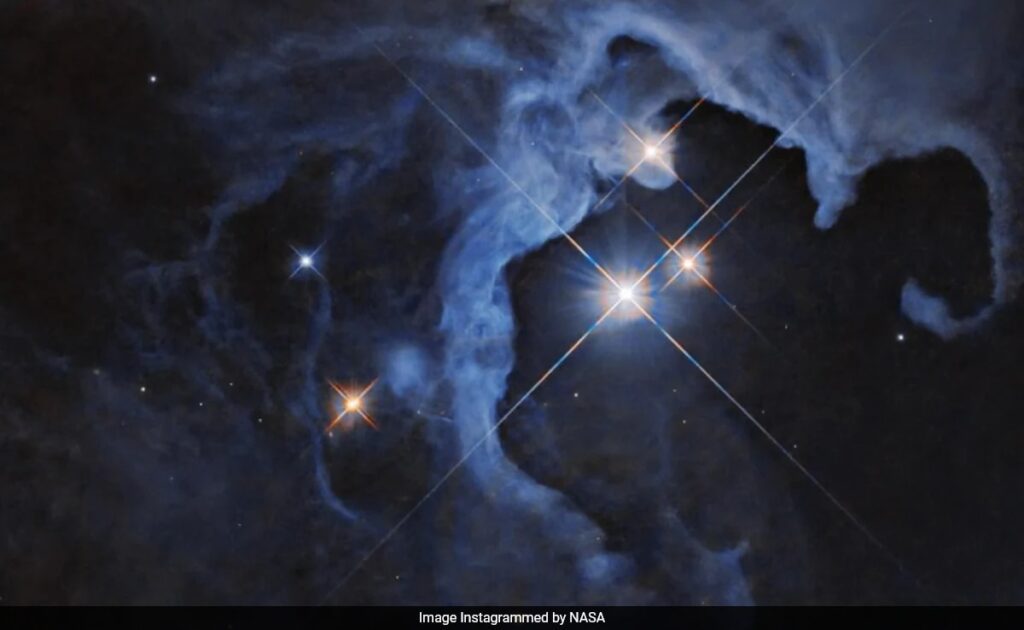Today’s Current Affairs: NASA’s Hubble Captures Triple-Star System 550 Light-Years Away
A breathtaking new image from the Hubble telescope shows a stunning cosmic spectacle – three young stars emerging from a sculpted cavity within a glowing nebula. Known as HP Tau, this triple-star system consists of members HP Tau, HP Tau G2, and HP Tau G3.
The brightest star in the trio, HP Tau, is just 10 million years old, compared to our Sun’s 4.6 billion years. It is on its way to becoming a Sun-like star, still cloaked in dust and gas from its birth, creating a swirling nebula around it. The star’s brightness fluctuates due to various factors, making it an intriguing object to study.
This fascinating system, located 550 light-years from Earth, is a beautiful example of the wonders of space, showcasing the beauty and complexity of our universe.
Which star in the HP Tau triple-star system is the youngest?
– A. HP Tau G2
– B. HP Tau G3
– C. HP Tau
– D. None of the above
Answer: C. HP Tau
What type of star is HP Tau classified as?
– A. Red Giant
– B. White Dwarf
– C. T Tauri
– D. Neutron Star
Answer: C. T Tauri
What causes HP Tau’s brightness to fluctuate?
– A. Swirling disk feeding the star
– B. Material falling onto its surface
– C. Giant sunspots on its surface
– D. All of the above
Answer: D. All of the above
How old is HP Tau compared to the Sun?
– A. More than 10 million years old
– B. Less than 10 million years old
– C. Equal to Sun’s age
– D. Unknown
Answer: B. Less than 10 million years old
What is HP Tau?
HP Tau is a triple-star system consisting of three young stars named HP Tau, HP Tau G2, and HP Tau G3.
How old is HP Tau compared to the Sun?
HP Tau is less than 10 million years old, while the Sun is around 4.6 billion years old.
What is a T Tauri star?
A T Tauri star is a young stellar infant that has not yet ignited nuclear fusion but is on its way to becoming a Sun-like star.
What is a reflection nebula?
A reflection nebula is a type of nebula that does not create its own light but instead reflects the light of nearby stars, similar to a dusty cloud illuminated by car headlights on a foggy night.
How do astronomers determine the age of a star?
Astronomers determine the age of a star by studying various factors such as its brightness fluctuations, the material falling onto its surface, and other characteristics that change as the star evolves over time.
Today's current affairs bring us a stunning new image captured by NASA's Hubble telescope. The picture showcases a triple-star system named HP Tau, located 550 light-years away. This mesmerizing system consists of three young stars - HP Tau, HP Tau G2, and HP Tau G3. HP Tau, the brightest star in the trio, is a mere 10 million years old, in contrast to our 4.6 billion-year-old Sun. Classified as a T Tauri star, HP Tau is on its way to becoming a Sun-like star, surrounded by swirling dust and gas leftover from its birth. The image, posted on Instagram by NASA, has garnered fascination and awe from users, with one asking about the formation of stars and another inquiring about how the age of a star is determined. The cosmic spectacle of HP Tau serves as a reminder of the beauty and complexity of our universe.
Today's current affairs bring us a stunning new image captured by NASA's Hubble telescope. The image showcases a triple-star system called HP Tau, located 550 light-years away. This system includes three young stars - HP Tau, HP Tau G2, and HP Tau G3.
HP Tau is the brightest star in the trio and is considered a stellar infant at only 10 million years old. Unlike our own Sun, which is 4.6 billion years old, HP Tau is still in the process of igniting nuclear fusion to become a Sun-like star. The star fluctuates in brightness due to various factors such as swirling disks feeding the star and material falling onto its surface.
The image shared by NASA on Instagram reveals a beautiful cosmic spectacle with the stars surrounded by a nebula that acts as a celestial mirror, reflecting their brilliance. Users on Instagram commented on the post, questioning how stars are formed from nebulae and expressing awe at the magical and spectacular sight of the stars. This latest discovery from NASA provides a glimpse into the fascinating world of celestial bodies and their formations.







1 thought on “NASA’s Hubble Captures Triple-Star System 550 Light-Years Away: Current Affairs Question and Answers”